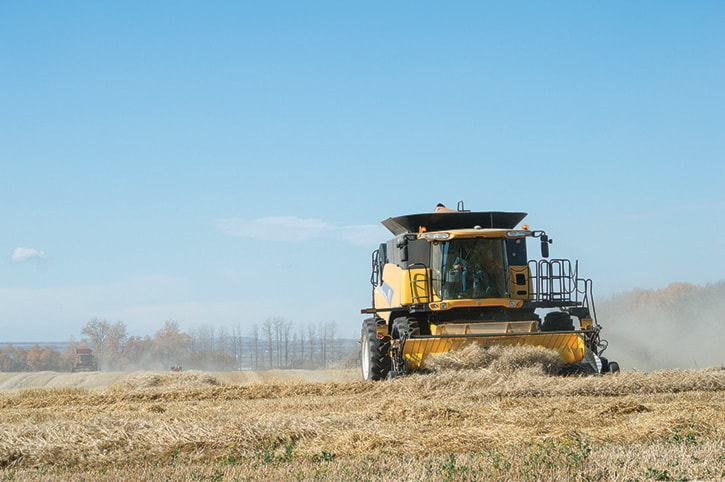Nine combines, one antique grain cart, two semi trucks, a baler and many helping hands brought in the Central Alberta Foodgrains Charity Growing Project harvest this past Saturday.
The 145-acre field a few minutes east of Lacombe was a hub of activity throughout the afternoon with volunteers donating their time and equipment, all to raise funds to feed hungry people in developing countries.
The locally-based charity entered into its 20th year of helping meet the growing international need for food security. Each year, through community involvement, the Central Alberta Foodgrains Charity Growing Project produces a crop on donated or rented land, and then after harvest, donates the proceeds to the Canadian Foodgrains Bank.
The funds raised through the project are used to help fight world hunger and are matched at a four to one ratio by the federal government.
Emergency food for people who are hungry in result of war, drought and international trade policies are assisted, along with providing tools and training for small-scale farmers. Current important donations of food are being sent by the Canadian organization to Syrian refugee camps, the south Sudan, Jordan and Lebanon.
Andre Visscher, Canadian Foodgrains Bank Southern Alberta coordinator, said the way the national organization operates now is different from how they began.
“Farmers would get together and grow, for instance wheat, and would ship the wheat to the Canadian Foodgrains Bank, and then we would ship that overseas,” he said. “We don’t do that anymore. Today, we are selling the crop and buying food in the area where it is needed. It saves a lot of time and we can do more that way.”
The Canadian Foodgrains Bank is working in 39 countries currently and has 255 growing projects across Canada. The local project is one of 34 in the province.
But even though the name sake of the organization leans towards grain, Visscher said the Canadian Foodgrains Bank raises funds through a variety of livestock and crop options.
“We have livestock auctions that allow some people to sell cattle,” he said. “Even in Nova Scotia, they do one with lobsters.”
The growing projects nation-wide vary from pumpkins and canola, to cattle and pigs.
“It really can be anything - a crop or livestock,” he said. “It is a way of raising funds.”
The local crop, which over the years has varied from canola, barley, spring wheat or winter wheat, after it is harvested, is sold locally at an elevator in Central Alberta. Last year, the project raised $74,250 and with the matching government dollars, amounted to $371,250.
On Saturday, over 100 people gathered in the field to kick off the one-day harvest with a barbecue. Those who donated seed, equipment or fertilizer, were joined by their family, friends and community members to enjoy a hamburger before the combines were brought to life and the dust was flying.
To clear the field, it took the group just over two hours, a testament to a true community effort.
“It’s the community that has kept it going over all these years,” said Doug Maas, long-time committee member.
With three original committee members still participating in the growing project, the group has met many challenges over 20 years, including poor weather and growing conditions.
The process for growing the crop each year begins in January. The committee meets and begins the search for a piece of land within Lacombe County. Once the land is secured, input suppliers are approached to provide seed to start. In the spring, local farmers donate their time to prepare the soil and then seed. Afterwards, local agri-businesses are approached to provide fertilizer and other supplies.
This year’s crop was seeded in early May, and with the harvest, brings the project’s duration to 10 months.
news@lacombeexpress.com
